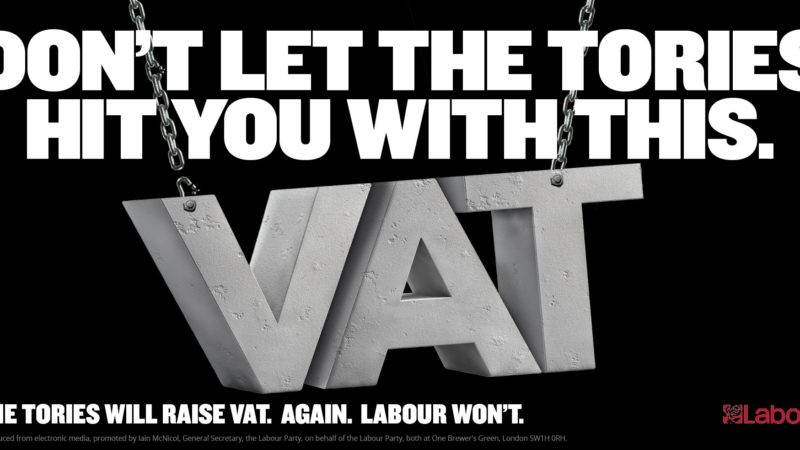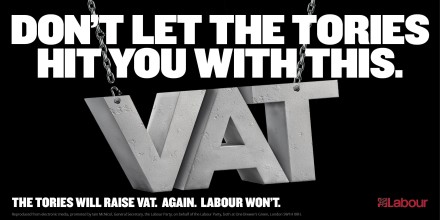
Ed Balls yesterday ruled out any rise in VAT under Labour. “We will not put up VAT,” he said. “And we will not extend it to food, children’s clothes, books, newspapers and public transport fares.”
Pretty unequivocal stuff, and surprisingly so: ruling out something like this usually comes as a response to speculation that you might be planning to do it. But no one was suggesting Labour were thinking about a VAT hike. No one had even mentioned VAT.
By mid-morning, it was a little clearer. Labour launched a poster warning that the Tories are planning to hit voters with more VAT after the election:
Then, early afternoon, they launched a new attack video, with a timeline showing several times there were Tory promises not to raise VAT – followed by the Tories raising VAT.
The great big clunking message to take away from this, just in case you missed it, it’s that the Tories are going to raise VAT, despite their claims to the contrary.
It wasn’t subtle, but was it effective?
The Conservatives are likely to go big on tax before the election. They have already produced posters about Labour’s plans to raise tax, and with the promise of billions of pounds of tax cuts by 2020, they are likely to want make the issue a ‘dividing line’. They know they are on strong ground: they have a six point lead over Labour on the issue of taxation. To put that in perspective, it is only a better score for Labour from the last election by a net point of one.
And, obviously, Labour will raise taxes: the Mansion Tax, the restoration of the 50p tax for top earners and bankers’ bonus tax are all high-profile taxes the party are happy to talk about. Especially when it can be compared to this Government’s tax cut for high earners, which came a year after they broke their promise not to raise VAT.
Labour’s big day on VAT is an attempt to neutralise a ‘Tory tax cuts vs Labour tax hikes’ framing. They are trying to “shoot the Tories’ fox”, to use the ugly common political parlour. The Conservatives, as the video demonstrates, have enough history of taking liberties with VAT promises, to give the attack credibility.
It also has a wide appeal. The left have always been opposed, given it is a fundamentally regressive tax, taking more from the incomes of the poorest than the wealthiest – which is why the Labour Party has never increased it.
There is a great deal of agreement on the right. In December, the Taxpayers’ Alliance denounced VAT as the “most burdensome tax for households in the lower half of the income scale”. By raising it as an issue, Labour have opened the door for pressure to be put on Osborne and Cameron from their right wing. What is the worst case scenario for Labour here? That Osborne is forced to unequivocally rule out a VAT rise? That would see Miliband and Balls setting the agenda, Osborne caving to pressure from his grassroots, and, given he’s ruled it out before, wouldn’t even kill the attack. Win-win-win.
So, Labour are in a good position. They have a clever attack, that ties in with part of their bigger offer (the Cost of Living Crisis), that appeals to voters both inside and outside of their core support base, and helps head off a strong Tory attack line. It was smartly joined up, with speech, poster and video trailed throughout the day, showing that some of the problems the party experienced in putting together a coherent campaign grid last time around have been expunged. The question now is how far they are willing to push it.





More from LabourList
‘The Employment Rights Bill is a massive step forward – but we’re not done delivering for working people’
‘Britain’s G20 Presidency is Labour’s chance to lead a global reset’
Is Andy Burnham’s star dimming amid repeated hints at leadership ambition?